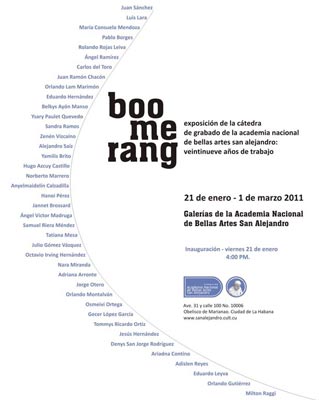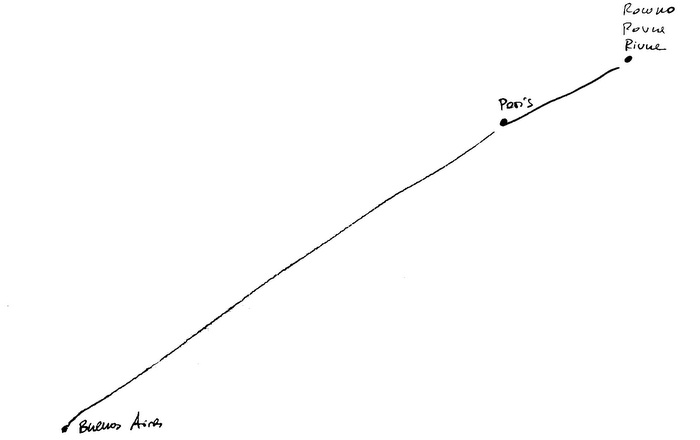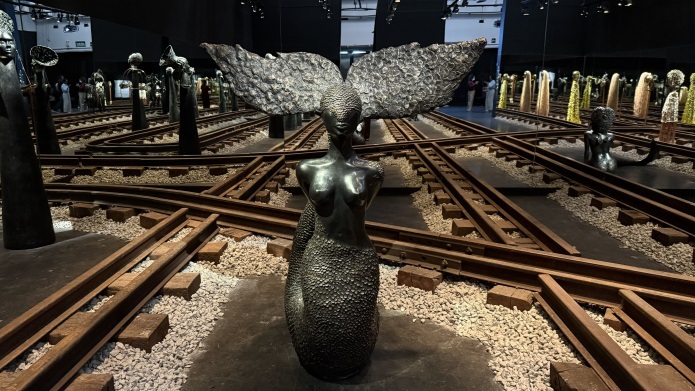
HAVANA: On the occasion of its 30 years of work, the Engraving Department of the San Alejandro National Academy of Fine Arts put on an exhibition named Boomerang that will be inaugurated January 21 at the institution.
Boomerang—open through March 1—is a selection of representative graphic works of art by former students and professors of the school of the past three decades. Among them are Belkis Ayon, Juan Sanchez, Luis Lara, Angel Ramirez, Eduardo Hernandez, Sandra Ramos, Agustin Rojas, Salvador Gonzalez, Pablo Borges, Carlos del Toro, Janette Brossard, Norberto Marrero, Anyelmaidelín Calzadilla and Milton Raggi.
With the purpose of broadening the public’s perception of the event, we have attached the text included in the catalogue of the exhibition titled: “Boomerang: Thirty years of San Alejandro’s Engraving Department,” by Eduardo Hernandez Santos.
BOOMERANG: THIRTY YEARS OF SAN ALEJANDRO’S ENGRAVING DEPARTMENT
It is the supreme art of the teacher to awaken joy in creative expression and knowledge
Albert Einstein
A little history
Boomerangtries to visualize thirty years of teaching of the Engraving Department of San Alejandro National Academy of Fine Arts of Havana.
Engraving was included in the curriculum of the school in 1982 bringing about encouraging results for both, the school and Cuba’s contemporary graphic arts.
San Alejandro’s Engraving Department was founded in 1928 with Spanish painter Mariano Miguel as its director until 1957. In 1958, engraver and painter Carmelo Gonzalez, who was chairman of the Engraving Association of Cuba founded in 1949, took on the post until 1962. Carmelo was not only an excellent engraver and draftsman, but also a great leader and promoter of Cuban graphic arts during the 1950s and 1960s. He taught engraving and brought several artists together around the craft, while promoting national graphic arts by means of exhibitions in Cuba and abroad.
Engraver and journalist Juan Sanchez was named head of the department in 1962; he held the post until 1985. Sanchez was also San Alejandro’s director from 1976 to 1978 (according to consulted sources). His studies were brought to light in several publications about Cuban art, being one of the most outstanding ones: Engraving in Cuba (1955).
From 1985 to 1994 engraver and draftsman Angel Ramirez was appointed head of San Alejandro’s Engraving Department. Ramirez’s teaching efforts set a turning point in the teaching of engraving at School as he addressed for the first time emerging problems such as the object-based character of engraving, deconstruction of prints to be used in a different way and mold as a work of art. His work falls within a generation of young engravers newly graduated from the Cuban Higher Institute of Arts (ISA), who had fresh ideas that, together with him, played an interesting role in the teaching of engraving in the 1980s. Among such young artists were: Agustin Rojas, Salvador Gonzalez, Pablo Borges (who developed an exquisite and rigorous work in the formal sense and was highly demanding in terms of teaching methodology), Carlos del Toro, who introduced wider-scope criteria and more experimental elements regarding the implementation of old lithography study programs of. At that point, the usefulness of technique as a means rather than as an end within engraving had been already started to be questioned.
From 1996 to 1997 Eduardo Hernandez Santos –engraver, draftsman and photographer– became head of San Alejandro’s Engraving Department. He attended the Academy in the 1980s and was from one the first graduations of engraving. Hernandez Santos started his career as a graphic artist, but later expanded his work to photography. He started to work as a professor at San Alejandro in 1990 in the printmaking workshop for first year students. He taught the basic principles of engraving based on visual aid about the history of graphic arts and its consequences.
From 1997-2000, the post was held by engraver, draftsman and writer Norberto Marrero who was first a workshop assistant and was later promoted to professor at the request of Belkis Ayon. His lessons mixed literature and movies. This contributed to broaden the profile of the professional training and the sensitivity of students towards graphic arts in general.
Engraver and draftswoman Janette Brossard held the post of head of the Engraving Department from 2000-01. Brossard further strengthened the bond between students and teachers. According to her own words she never felt like “the boss” because “the most important was the link with her students.” Her work enquires into social context. She implements different forms in her engravings that go from the traditional print to installation resulting in a very positive referent for her students. In her graduate’s thesis project, Brossard linked the pedagogical space with the professional space of the gallery.
Finally, engraver and draftswoman Anyelmaidelin Calzadilla has been the head of the department since 2001. She has developed serigraphy and installation as aesthetic language bringing up contemporary social topics. As a professor, she teaches a workshop on serigraphy about the contents of engraving and its implementation.
Belkis Ayon’s Trace
San Alejandro was honored by the presence of graphic artist Belkis Ayon who worked as a professor at the school from 1991-98. Ayon never wanted to take on the post as head of the Department, maybe because of her multiple artistic and executive responsibilities outside the school.
However, her work as a teacher was relevant as stated by her students and work colleagues. Her educational efforts established great demands. She demonstrated that the craft of engraving demands deep ethic rigor and takes a lot of effort and sacrifices. Likewise her efforts to bring her students’ work into the art space were noteworthy, as she became a kind of promoter of up-and-comers. Having a lively personality, being visibly honest and surprisingly forceful, Ayon established guidelines in engraving because of her way to approach colography. In the first place the use of big formats, which was uncommon in traditional graphic art where mid-size formats usually prevailed. In the second place, Ayon changed colography’s constructive and formal language by displaying a wide range of high precision textures. It could be said that Ayon created a new language for colography, one that was less pictorial and more radically graphic. Her career was filled with awards and important recognitions, among them: National Prize of Engraving Meeting (1987), her exhibition at the venue of the Ludwig de Aachen Forum, Germany (1992), her participation in the Venice Biennial of 1993, the First prize of the 12th Biennial of San Juan de Puerto Rico of Latin American and Caribbean Engraving (1998). In addition, her works are part of collections of Los Angeles MOCA and New York MOMA, United States.
Because of both, the dimension of her art and her promotional work at events such as La huella múltiple, Ayon managed to reassess the Cuban engraving within the national cultural context and international art circuits. Ayon’s graphic work has become a reference, an example to follow to young artists who were once her students, to those who were never her students and to those who might be it someday.
The Bottom Line
Under the title of Boomerang, San Alejandro’s Engraving Department has organized this exhibit drawing three generations of Cuban engravers together (from 1980-to the present). The graphic display is not part of methodological grounds or class exercises but a selection of some of the works by professors and former students of the school who have shaped the geography of our Engraving Department and part of the Cuban contemporary graphic art. It is our purpose to show the interrelation established among the three generations of engravers by taking a closer look to their artistic productions.
Foundational space. The 1980s
The eighties were an important moment in the forging of future generations of graphic artists in Cuba. The leadership of the San Alejandro School was undertaken by ISA young newly graduate artists who had new methodological approaches bringing about greater freedom and creativity.
Boomerangseeks to provide a closer look to the work of professors and students trained at the San Alejandro school in the 1980s, during which traditional print prevails, the good craft of the engraver was marked by languages of new figuration, neo-expressionism, magical realism, surrealism, abstraction, and by topics such as religiosity, landscaping, popular issues, artistic appropriations, intimist and anthropologic approaches. The 1980s meant the introduction of changes in the conception and presentation of engraving, but not as a general concept, but as an expression of particularities (Angel Ramirez’s work). It was a decade in which traditional engraving techniques of extremely high professional level were praised, and at the same time, the first actions that would bring a change in the following year were already taking place.
“Prodigious Decade”: the 1990s
The 1990s accounted for the continuity and sedimentation of techniques and artistic forms of engraving initiated in the 1980s, as well as the introduction of new expressions such as installations and big formats. This was a time of an outbreak of proposals of immeasurable strength and maturity, with a great balance in shape and content. There is still respect for the craft while moderate transgressions emerge including installation making, the object-related, and the reconstruction and construction of the artistic object. Engravers show their commitment to their social and political environments dealing with such topics like immigration, precariousness of daily life, new approaches of customs novel and new readings of history for which they use different discourse strategies like irony and metaphor. This decade shows a feverish display of graphic works of art marked by personal character and aesthetic beauty.
The highly innovative: the 2000s
The highly innovative are the result of logical continuity and rupture. They burst in with accumulated experience in La huella múltiple, and by adding up together individualities and artistic excellences of the 1990s. It is in the 2000s that engraving is definitely presented in the big format, installations and the object-related. Young artists show a marked interest in self-reference, social commentary and daily life events, creating subtle metaphors about their vital space. Nevertheless, there are a few artists who continue to be interested in recovering the craft of traditional engraving. The traditional corporeal character of contemporary “engraving” had been highly modified by assimilation, combination and overlaying of prints in so many different materials like plastic, fabric, industrial printing, machines, based on traditional printing techniques to obtain new results. Engraving is constantly suffering mutations of different kinds making it easier to expand creative horizons.
This is how the name Boomerang, a primitive weapon from Australian Aborigines that sets a circular route to later return to its place of origin, becomes a metaphor of the School space, a filter of projections from inside out and vice versa, an enriching and everlasting exchange between teacher and student, a cycle of different and complex references, a meeting place, a place for projections towards the space of art and from this one towards ourselves, a place for never ending interactions and actions.
Eduardo Hernandez Santos
Havana, December 2010
SAN ALEJANDRO NATIONAL ACADEMY OF FINE ARTS
Avenida 31 y calle 100, no. 10006
Obelisco de Marianao, Havana














